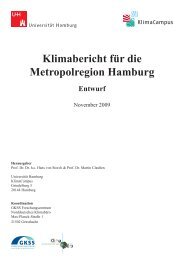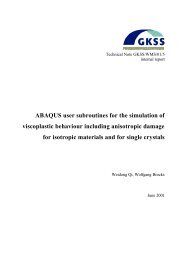Dynamics and Vulnerability of Delta Systems - loicz
Dynamics and Vulnerability of Delta Systems - loicz
Dynamics and Vulnerability of Delta Systems - loicz
You also want an ePaper? Increase the reach of your titles
YUMPU automatically turns print PDFs into web optimized ePapers that Google loves.
depth <strong>of</strong> flooding for 10yr, 20yr, 50yr, 100yr, <strong>and</strong> 500yr flood events. FEMA maps are available<br />
for all deltas in the USA <strong>and</strong> similar maps exist for many other industrialized countries.<br />
Other types <strong>of</strong> risk that might be mapped analogously could include subsidence risk, erosion risk,<br />
distributary channel avulsion risk, tsunami risk (Case Study 9), <strong>and</strong> sensitive ecosystems or<br />
species. The choice <strong>of</strong> risks to be mapped would focus our attention on what necessary data is<br />
available <strong>and</strong> what data requires development, <strong>and</strong> what types <strong>of</strong> models may be needed to<br />
develop a mapping methodology analogous to that used for floodplain mapping. The various<br />
maps <strong>of</strong> different types <strong>of</strong> risk/vulnerability could then be overlain to see if there are hotspots <strong>of</strong><br />
risk/vulnerability, either on a global scale or a local scale.<br />
CS9 Tsunami risk on the Fraser River <strong>Delta</strong><br />
Philip R. Hill<br />
The Fraser River <strong>Delta</strong>, located on the Pacific coast <strong>of</strong> Canada, is the site <strong>of</strong> several suburban<br />
centers <strong>of</strong> Metro Vancouver <strong>and</strong> <strong>of</strong> major transportation infrastructure. The international airport <strong>and</strong><br />
residential areas <strong>of</strong> the delta lie below high tide level <strong>and</strong> are protected against flooding by earthwork<br />
dykes. Recent research indicates that the delta plain is subsiding by an average <strong>of</strong> 1 to 2 mm yr-1<br />
(Lambert et al. 2008). In this seismically active area, the risk <strong>of</strong> a tsunami causing sudden <strong>and</strong><br />
extensive flooding is significant. There are three possible mechanisms for generating tsunamis in the<br />
area: 1) displacement on active faults in the Strait <strong>of</strong> Georgia, 2) movement related to subduction<br />
zone mega-thrust earthquakes in the <strong>of</strong>fshore, <strong>and</strong> 3) submarine l<strong>and</strong>slides.<br />
Faults showing Holocene displacement <strong>of</strong> the seabed have been mapped in the Strait <strong>of</strong> Georgia<br />
(Barrie & Hill 2004), <strong>and</strong> Puget Sound (Atwater & Moore 1992). The return period <strong>of</strong> movement on<br />
these faults is long (>1000 years), but the potential displacement <strong>and</strong> resulting tsunami would be<br />
large. A tsunami generated by a mega-thrust earthquake on the <strong>of</strong>fshore Cascadia subduction zone<br />
has a higher return period (500 -700 yrs) <strong>and</strong> would propagate into the Strait <strong>of</strong> Georgia. However,<br />
model simulations suggest that the tsunami waves would be dissipated by passage into the strait <strong>and</strong><br />
would be unlikely to exceed 1 m in height on the Fraser <strong>Delta</strong> (Cherniawsky et al. 2007).<br />
<strong>Delta</strong>s are well known as the sites <strong>of</strong> submarine l<strong>and</strong>slides. Main Channel <strong>of</strong> the Fraser River has<br />
been fixed in place by training jetties since the 1930s (Luternauer & Finn 1983), which has resulted<br />
in local progradation <strong>and</strong> over-steepening <strong>of</strong> the delta slope. Sedimentation rates at the river mouth<br />
exceed 1 m yr-1 <strong>and</strong> small slope failures have occurred several times over the last 30 years (Hill, in<br />
press). There is also geological evidence on the delta slope for older slope failures <strong>of</strong> possibly larger<br />
scale (Mosher & Hamilton 1998). Numerical simulation <strong>of</strong> tsunami waves generated by delta slope<br />
l<strong>and</strong>slides indicate that for the extreme case <strong>of</strong> a major collapse <strong>of</strong> the delta slope, waves up to 18 m<br />
high would propagate away from the delta front (Rabinovich et al. 2003). On the delta itself, wave<br />
heights would be attenuated by the extensive tidal flats, but would potentially be high enough to overtop<br />
the dikes.<br />
The prospect <strong>of</strong> tsunamigenic slope failures is one <strong>of</strong> the motivations for incorporating sediment<br />
transport <strong>and</strong> slope stability instrumentation into the VENUS Submarine Observatory<br />
(http://www.venus.uvic.ca). A benthic l<strong>and</strong>er instrumented with ADCP current meters, pencil lasers<br />
<strong>and</strong> scanning sonar has been deployed near the river mouth <strong>and</strong> will be on-line in March 2008.<br />
Acoustic piezometers capable <strong>of</strong> measuring in situ pore pressures <strong>and</strong> seismic wave loading will be<br />
deployed in September 2008.<br />
One could also compare vulnerability maps for different scenarios <strong>of</strong> climate change, economic<br />
growth, or management (including management options to reduce risk). The advantage <strong>of</strong><br />
pursuing the risk mapping approach is that the FEMA floodplain map example is well understood<br />
by governmental agencies <strong>and</strong> insurance companies so that analogs are likely to be quickly<br />
accepted <strong>and</strong> adopted (Wisner et al. 2004). While the practicality <strong>of</strong> this task will appeal to<br />
41





